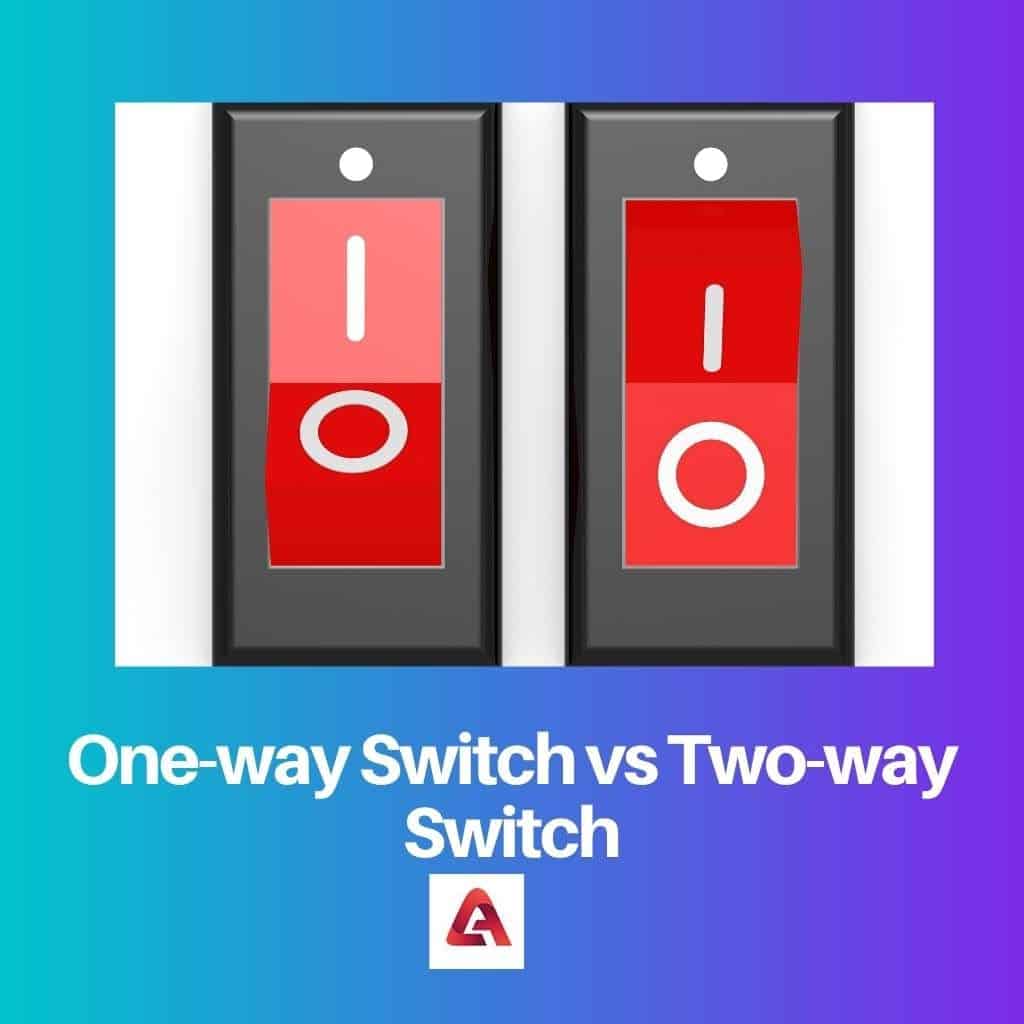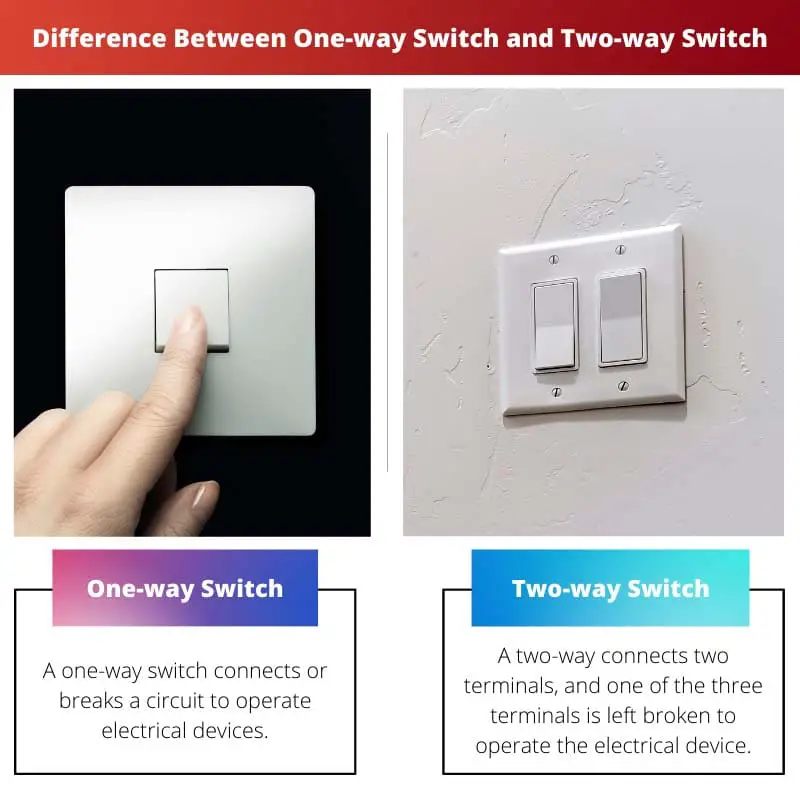One of the simple devices mostly used in everyday life is switches. A switch can join or break a circuit to operate other electrical devices.
If you look closely, a switch only has two functions – on and off any electrical device. In other words, it connects or breaks the circuit to work specific electrical devices.
A current can flow in the circuit till the switch is in the ON position to complete the circuit. It is used for electric lights, electrical appliances, and other electric outlets.
Key Takeaways
- A one-way switch is a simple on/off switch that controls one light or electrical device from one location, while a two-way switch allows control of the same light or device from two different locations.
- A one-way switch has only two terminals, while a two-way switch has three.
- Two-way switches are commonly used in stairways, hallways, and large rooms, while one-way switches are used in smaller rooms.
One-way Switch vs Two-way Switch
A one-way switch is used in a household to make or break connections between two terminals. The current flows in one direction to make electrical appliances function. A two-way switch is a common switch which has three terminals. The switch can be accessed from two different locations.

A one-way switch connects or breaks a circuit with two terminals. When the switch is on, it completes the circuit. But when the switch is off, it breaks the circuit, thereby the current doesn’t flow through the circuit.
Thus, the electrical appliance doesn’t work. Most common switches are used in every household.
A two-way switch is a combination of two one-way switches. However, the working differs as one of the terminals can be connected to either one of the three terminals.
But it can’t be connected to both terminals at a time. When one of the terminals is connected with another, the third terminal’s connection is broken.
Comparison Table
| Parameters of Comparison | One-way switch | Two-way switch |
|---|---|---|
| Principle of work | A one-way switch connects or breaks a circuit to operate electrical devices. | A two-way connects two terminals, and one of the three terminals is left broken to operate the electrical device. |
| Number of contacts | A one-way switch has two contacts | A two-way switch has three contacts. |
| Known | A one-way switch is also known as a single-pole switch. | A two-way switch is also known as a double-pole switch. |
| On and off position | A one-way switch has a defined on and off position. | A two-way switch does not have a specific ON and OFF position. Since it depends on the orientation of the switch. |
| Access | A one-way switch can be accessed from a single location only. | A two-way switch is accessed from two separate locations. |
| Installation and time | A one-way switch can be installed without any hassle in less time. | A two-way switch is installed with complications and consumes a lot of time. |
What is One-Way Switch?
A one-way switch is commonly used in every household. It connects or breaks a circuit with the use of two terminals. When the switch is on, the circuit is complete, and the current flows through it.
Thereby, the electrical appliance works. But, When the switch is off, it breaks the circuit, and the current cannot flow through it. Hence, no appliance can work.
The number of contacts determines the type of switch. A one-way switch has two terminals and is commonly used in small rooms and domestic electrical appliances.
In addition to terminals, a one-way switch has specific ON and OFF terminals. In short, a one-way switch has OFF and ON positions that determine whether the circuit is closed or open.
And there are some specific indications on the switch to identify the on and off switch.
Besides, a one-way switch is restricted to one location only as one cannot access it from another single place to switch on or off any electrical appliance. Coming to the installation, a one-way switch takes less time to be installed.
It gets installed easily because of its simpler functionality. Moreover, one-way switches are mostly used in smaller rooms, offices, homes, and domestic electrical appliances because the number of contacts and restrictions in one place makes it easier to use.

What is Two-Way Switch?
A two-Way Switch is not a common type of switch. It is composed of a combination of two one-way switches together. Besides, the circuit breaks and completes, as usual, allowing the flow of current through it.
A two-way switch has more contacts than a one-way switch, as a result, there is a significant difference between them. It has three terminals.
Moreover, when the switch is on, one terminal is connected to another. But the third one has a broken connection as a result.
The three terminals cannot be connected at the same time. One of the terminals needs to be broken to work for specific electrical devices.
Coming to the usage of a two-way switch, it is not commonly used. However, it is preferable for large rooms, long corridors, and long stairways.
In addition to that, it can be accessed from two separate locations. Therefore, many people prefer a two-way switch to operate light and ceiling fans as it’s more convenient.
Another specialization of a two-way switch, its on and off terminal, is not specific because it depends on the position of a two-way switch.
There’s no consistency in the on and off position. Lastly, the installation of a two-way switch is much more complicated than a one-way switch and consumes a lot of time.
Main Differences Between One-Way Switch and Two-Way Switch
There are many types of switches available. One of the types of switches is the one-way switches and two-way switches. Compared to a two-way switch, the one-way switch is more used.
To operate every electrical device, there’s a need for a switch that completes the circuit to allow current to flow through it, thereby letting the electrical device work.
- The one-way switch connects or breaks the circuit to operate a specific electrical device, while the two-way switch doesn’t work as that two-terminal connects, and one of three terminals is left broken.
- A one-way switch has two contacts, while a two-way switch has three contacts.
- A one-way is also called a single-pole switch, while a two-way switch is also known as a two-pole switch.
- A one-way switch has a defined on-and-off position, while a two-way switch has no defined on-and-off position as it depends on the position of a two-way switch.
- A one-way switch is restricted to one location. In contrast, a two-way switch can be accessed by two separate locations.
- A one-way switch can be installed without much hassle in less time. On the other hand, a two-way switch is much more complex, therefore, it takes more time.

- https://link.springer.com/chapter/10.1007/978-3-662-53015-3_6
- https://www.sciencedirect.com/science/article/pii/S0167931704002084

The article does a great job of explaining the differences between one-way and two-way switches in a clear and easy to understand way.
I agree, the article is very informative and well-written.
This article is the perfect introduction to one-way and two-way switches for those who are new to electrical systems and wiring.
I believe the article could have delved deeper into the working principles of one-way and two-way switches, rather than just comparing them at a basic level.
I don’t agree with the article, it seems to oversimplify the differences between one-way and two-way switches, and doesn’t provide enough technical details.
I feel that the article could have provided more practical examples of when one-way and two-way switches are best used in real-life situations.
This article is fantastic! It offers a comprehensive comparison between one-way and two-way switches with clear examples and explanations.
The article is certainly very well-written and informative, but I couldn’t help but notice a slight lack of humor in its presentation. I suppose electrical switches aren’t the funniest topic to begin with!
The article does a fantastic job of explaining the nuances of one-way and two-way switches, which are misunderstood in everyday use.